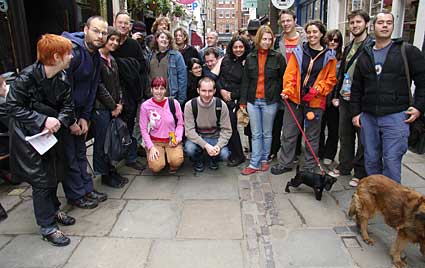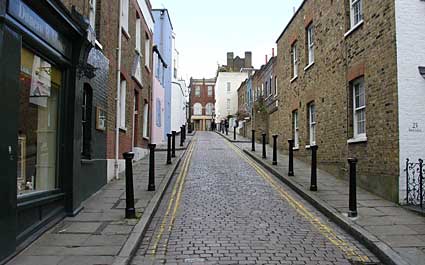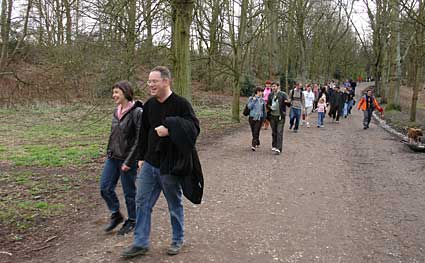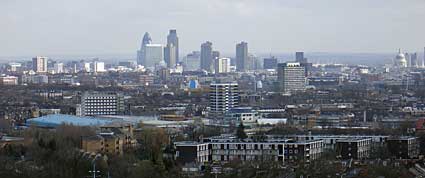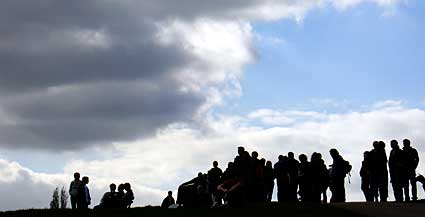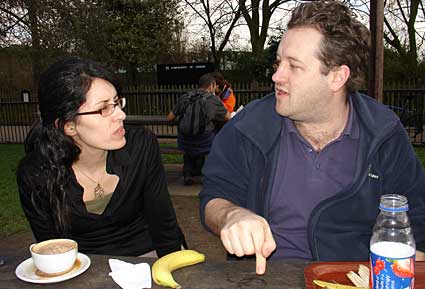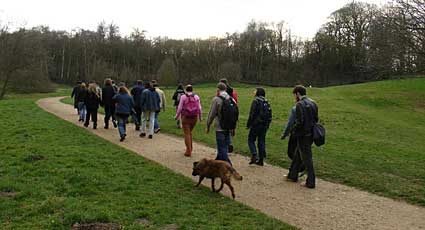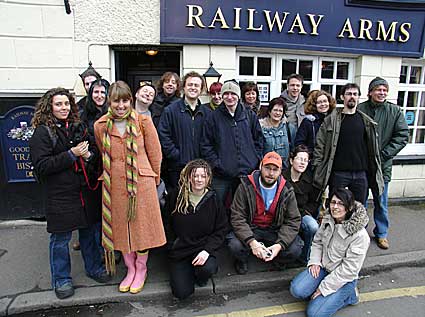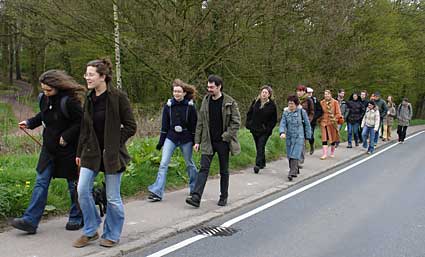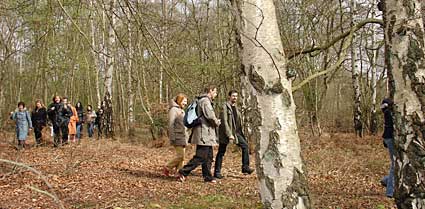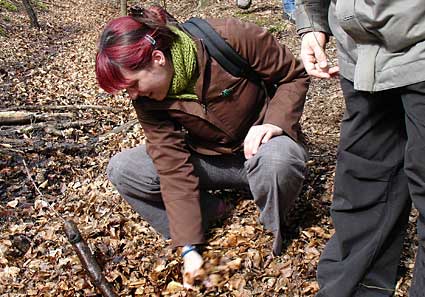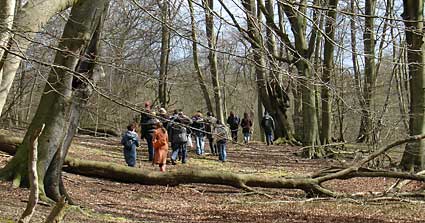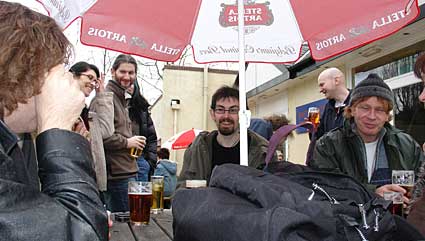Friday 22nd of April 2005 – Urban75 walks
You’re with your dad this weekend, which is a shame, because in Kew Gardens, the corpse flower has just flowered, it’ll stay in bloom for about 2-3 days. It’s about 1.60meters tall, and it smells like a rotting dead body. I read about it on the paper today and I’m dragging some people with me (Ed, Irene, J, Dave Roberts and Djazia) tomorrow… I’ve also been doing the London walks with Urban75, the first one was to Hampstead (25 people, including Ed and Irene), when we walked lots, and the second one was to Epping Forest (15 people) when we didn’t walk so much, got lost and ended up at the organisers’ house drinking all their wine and eating all their food!
Who knows if these links will still exist when you get to see it, but here goes (they are the reports written on the walks by Mike Slocombe, ‘editor’ and creator of Urban75 – all the photos on the reports were also taken by him)
Hampstead walk: http://www.urban75.org/london/hampstead.html
Hampstead walk: A walk around Hampstead Park, north London
Report by urban75 editor, March 2005A king-sized urban75 posse was out in force for the March walk, chosen by walk-veteran, Cloo.
The walk took us around Hampstead Heath, a 791 acre park made up of the grounds of several large houses that once occupied the area.
Meeting outside the Flask pub, 14 Flask Walk, HampsteadHidden away in the picturesque Flask Walk (On Heath Street, 2 mins from station), is the Flask public house, a traditional Victorian boozer.
Both Hampstead and nearby Highgate have pubs called the Flask, recalling the centuries-old practice of Londoners climbing up to the two villages to fill leather flasks with pure spring water rather than risk the cholera-riddled infected waters of London.
The Flask is a down-to-earth, no-nonsense pub, offering reminders of Hampstead’s roots as a working-class village of lowly cottages before the luvvies, yuppies and toffs swarmed in.
We enjoyed a couple of excellent Youngs ales before setting off on what was to be a gentle afternoon’s walk.
Back Lane, HampsteadHampstead’s got a long history. The earliest known inhabitants of the Hampstead area were Mesolithic forest hunters who settled here in about 7000BC, with their campsites being excavated on the West Heath between 1976 and 1981.
A barrow on Parliament Hill suggests that there was a Bronze Age settlement on this desirable hilltop.
The Doomsday Book of 1086 showed that Hamestede (meaning homestead) was centred on a small farm, which was valued at fifty shillings. In the Middle Ages two windmills and a chapel (later a parish church) appeared on Hampstead hill, with the village remaining a peaceful rural community until the end of the seventeenth century.
In 1698, six acres of wastelands on Hampstead Heath containing ‘certain medical waters called the Wells’ were granted at a yearly rent of five shillings on the condition was that they apply it ‘for the sole use benefit and the poor of the parish of Hampstead’.
The wells were promoted on the medicinal value of the chalybeate waters (water impregnated with iron), and drinking rooms and an Assembly Room for dancing, concerts and other forms of entertainment was erected in the early 1700s.
After a bright start, Hampstead Wells’s popularity declined, a casualty of competition with other London spas and entertainment and problems with rowdy behaviour.
By the end of the 18th century Hampstead’s days as a spa were over, but they’d managed to attract substantial development in the area and established its reputation as a healthy and attractive place to stay.
The 19th century saw Hampstead expanding with the 1860 North London Line (‘Silverlink’) bringing in crowds of day-trippers to enjoy the Heath.
By 1891 the population of Hampstead had doubled to 68,000 from its 1871 total, spurring on the building of new churches, chapels, schools, police and fire stations, a cemetery, water supply and sewage system, with a Town Hall being built in Haverstock Hill in 1878.
Hampstead became part of London of 1888.
The 1939-45 World War II brought periods of heavy bombing around Hampstead, with the deep tube station being used as air-raid shelters.
After the War, rebuilding was slow, with Hampstead’s first post-war Council Blocks, The Wells House flats being built in 1948 on the site of Weatheral House.
On the march!
The twenty-five strong walking crew start stomping through Hampstead Heath.
Pond, Hampstead HeathThe larger ponds were created on Hampstead Heath as reservoirs for London’s water supply in the 17th and 18th centuries.
There are over 30 ponds on the Heath, with the six major ones being in two different valleys (one of them in the valley of the River Fleet).
Picnicking by the ponds
A couple enjoy the warm(ish) March weather and partake in a picnic on Hampstead Heath.Climbing the hill
Hampstead Heath is London’s highest open space, with Parliament Hill reaching 134m (441ft) above sea level.
View from Parliament HillParliament Hill offers superb views across London and the surrounding countryside.
There’s two explanations for the name ‘Parliament Hill’: some reckon it acquired the name because it was where Guy Fawkes and his fellow conspirators stood looking towards parliament waiting for it to explode.
A more probable explanation is that the Hill was a point of defence during the English Civil War for troops loyal to parliament.
It’s also rumoured that Boudiccia (Boudicca) was buried nearby, although some people believe she rests under Platform 10 at London’s King’s Cross Station!
Centre left in the distance you can see the curved tip of the ‘Erotic Gherkin’ skyscraper, with Tower 42 to its right. To the far right, you can see the dome of St Pauls.
Looking over London
An old couple take in the fabulous view from Parliament Hill.
At the summit
There was quite a crowd of people at the top of Parliament Hill.
Stone of Free Speech , Hampstead Heath
There was supposed to be some ancient significance to this stone. Perhaps the arrangement of beer cans and bottles scattered around point to a nearby ley line. Or something. (Quick rummage around google later): ah got it – the Stone of Free Speech was the focus of religious and political meetings on the Heath 200 years ago.
In the tea room
The presence of the downwardly thrusting finger stabbing the table says that there is A Very Big Point being made here.
Pond, Hampstead Heath
Looking across one of the many ponds on Hampstead Heath.Hampstead Women’s Pond
Three of the large Heath ponds are used for bathing, one mixed, one for women, and one for the men.The women’s pool lies at the end of a winding country pathway and with a ban on radios and mobile phones, provides a peaceful retreat.
Grecian Fountain
Constructed in the 1920s, this fountain now enjoys Grade II listed status.False Bridge.
This ‘bridge’ by Kenwood House is not what it seems: it’s actually a wooden folly with only one side!Kenwood House
There’s been a house on this site since 1616, but the current neoclassical mansion was remodelled by Robert Adam between and William Murray, 1st Earl of Mansfield between 1764-73.Standing at the edge of Hampstead Heath in North London, the Kenwood House has fabulous landscaped gardens with open air concerts held in the bowl by the lake during the summer.
Kenwood House entrance
The estate was bought in stages for the nation in the 1920s, with the Kenwood House and the final 74 acres being entrusted to the nation opn the death of Edward Cecil Guinness, 1st Earl of Iveagh in 1927.Guinness had furnished the house and installed what was to become the most important private collection of paintings ever given to the nation, the Iveagh Bequest.
Kenwood House is reached from Hampstead Lane by a wooded drive.
The frontage is flanked by white brick wings, housing the Music and Dining Rooms, added by George Saunders for the 2nd Earl.
Kenwood House
Admission to the house is free and visitors can admire priceless paintings by such masters as Rembrandt, Turner, Reynolds and Gainsborough.Part two: http://www.urban75.org/london/hampstead1.html
Hampstead walk: A walk around Hampstead Park, north London
Report by urban75 editor, March 2005
Part two of our Spring walk around Hampstead Heath, London
Walking through Hampstead HeathMindful of the pub ahead, the intrepid walkers headed north through the heath.
By this time, we’d lost a few of our fellow strollers who had been irresistibly tempted by another pub a mile back.
Funfair, Hampstead Heath, north London, England
Funfair, Hampstead HeathEach Bank holiday the Heath hosts a large funfair. Business didn’t seem too brisk when we walked past.
Jack Straw’s Castle, North End Way, north London, England
Jack Straw’s Castle, by Hampstead HeathTragically, this Grade II listed building in North End Way closed to the public last year after Camden Council’s planning committee voted by six votes to five to convert the ground floor into a private health club.
The much-admired 1960s Gothic style building replaced the previous historic pub on the site, where highwayman Dick Turpin, poets Keats and Shelley and novelist Charles Dickens had all stayed. The pub was flattened during World War II.
The pub was named after Wat Tyler’s second-in-command in the Peasant’s Revolt of 1381, who is believed to have lived on the site.
The Spaniards Inn, Spaniards Road, Hampstead north London, England
The Spaniards Inn
This charming pub built by a former toll-house is rich in history, spawning a multitude of tales of varying credibility.Some believe the name reflects the fact that it was built as a residence for the Spanish ambassador to the court of James I.
Others suggest that it was turned into an inn by two Spaniards in the 18th century, who fought a duel over a woman who then spurned them both.
During the Gordon Riots of 1780, anti-Catholic mobsters stopped off at the Spaniards Inn in Hampstead en route to Kenwood House, which they intended to loot, plunder and burn to the ground.
The publican plied the rioters with so much free beer that they were in no fit state to stand up, let alone destroy Kenwood House. When the army arrived the rioters were disarmed with little effort.
The pub also claims to be the birthplace of Dick Turpin, who was certainly active in the area during the early 18th century – he even had a secret tunnel built connecting two Highgate pubs so he could escape his pursuers.
Legend has it that Turpin stabled his horse, Black Bess, in the toll house across the road.
The pub can also claim to be the inspiration for one of Keats most famous odes: when John Keats heard a nightingale singing in the inn’s back garden, he whipped out his quill and wrote Ode to a Nightingale.
Drinking at The Spaniards Inn, Spaniards Road, Hampstead north London, England
Drinking at The Spaniards InnThe pub features a large trellised back garden, with fairy lights decorating a large central tree. The food was great, as was the ale!
Drinking at The Spaniards Inn, Spaniards Road, Hampstead north London, England
More drinking at The Spaniards InnWe stayed for a lovely couple of pints before heading back to downtown Brixton.
The Spaniards Inn, Spaniards Road, Hampstead, north London, England
Exterior view of the pub – note the bottleneck between the pub and the old toll gate (to the far left).
Epping Forest Walk: http://www.urban75.org/london/epping.html
urban75 walk club: Epping Forest in the spring
Report by urban75 editor, April 2005
A walk through Epping Forest, Essex.Theydon Bois tube station, Essex
The station was opened in 1856, with the line being electrified and incorporated into London Underground (Central Line eastern extension) on the 9th September 1949.Station sign with covered up Ongar branch
At Epping (one stop up from Theydon Bois), tube passengers used to be able to enjoy a ride on a delightfully anachronistic country branch line to the small town of Ongar.
Opened by the Eastern Counties Railway on 1 April 1865, the Ongar branch was mainly used for taking agricultural produce from the nearby farms into central London.
British Rail steam locomotives ran a shuttle service from Epping to Ongar from 1949 to 1957 before the line was electrified and incorporated into the Central Line.
I rode the Ongar branch several times before it closed on September 30, 1994 – see history of the Epping to Ongar railway
Happily, the line is currently in the process of reopening as a preserved line: Epping Ongar Railway website.Railway Tavern, Theydon Bois, Essex
True to tradition, we met up in a pub and enjoyed a few pints before setting off.The Railway Tavern is conveniently right next to Theydon Bois station, and their friendly staff served up a fine set of sandwiches. The beer wasn’t bad either!
Group shot, Railway Tavern, Theydon BoisGetting this lot to stay in one place long enough to take this photo was a bit like herding cats, but here’s the all-important ‘about to start the walk’ shot.
On the march, Theydon BoisHeading to Epping Forest through Theydon Bois (pronounced ‘boys’).
The town is listed in the Domesday Book as having a mighty population of 10, which had risen to the heady heights of 538 hardy souls in 1841.
The railway arrived in 1865, with gas following in 1872.Water was piped in during 1879 with the 1931 census reporting a population of 1,504 in 395 households.
By 1991, the village had grown to 1,530 households with a population of 3,946.
Passing Theydon Green
Walking west out of Theydon Bois past Theydon Green.I’m sure you’ll be as thrilled as me to learn that Theydon Bois won the Essex ‘Best Kept Village’ award in 2004. Go Boisy!
Sixteen String Jack, Theydon Bois
This unusual pub name refers to Jack Rann who was hanged at the age of 24 in 1774.Despite his young age, saucy Jack had packed a lot into his short life, managing to be tried and acquitted six times for highway robbery.
It turns out Jack was a dandy, described as being “remarkably clean and neat in his dress and always with sixteen silken strings tying his breeches to his knees and a satin waistcoat laced with silver”.
The key to Jack’s success in court was that he always carried out his crimes wearing a mask and dressed like a scruffbag.
Whenever he swanned into court in his Sunday finest, witnesses were unable to believe that he could possibly be the same guy, and was thus acquitted.
Jack became unstuck after he robbed Doctor Bell, a chaplain to Frederick the Great of Prussia, whose political connections ensured that Jack met the hangman’s rope.
Sadly, we didn’t get chance to investigate the pub, but word is that it’s well worth a visit!
Stomping through Epping Forest, Essex
Formerly a Royal Hunting Forest, Epping forest stretches for over 12 miles from Manor Park in the south, through the eastern fringes of Waltham Forest, to Thornwood in Essex.The forest covers over 6,000 acres – two thirds of which are woodland and one third rough grazing land and water – and is protected by the Epping Forest Act of 1878.
The area has been wooded for centuries with a history of ancient ‘common’ rights and is designated a Site of Special Scientific Interest (SSSI).
Bog trouble in Epping Forest
Griff’s ‘ad-hoc’ style of walk leadership meant that several people got very acquainted with this stream which was surrounded by a glutinous bog.Here you can see a fellow walker slowly sinking into the mud, while there appears to be some confusion as to where we should all be heading at this point.
Lost trainer in the mud
A leap across the stream into a super-sticky mud bank resulted in one of Eme’s trainers literally vanishing.
After some quagmire-tastic rummaging around, the shoe was thankfully recovered, albeit a little browner than before.
Walking through the forest
Epping Forest is one of the last parts of the great oak forests that surrounded London until medieval times and harbours over 360 rare plants and animal species.Here you can see the urban75 mob slowly disappearing into the distance.
Epping Forest view
The forest is a beautiful place to roam around on an afternoon, although a tourist leaflet warns, ‘be careful – although the forest is never more than a mile from a road, it is still very easy to get lost here.’I think it’s fair to say we won’t be arguing with that statement!
Epping Forest view
We didn’t manage to see any, but apparently there’s about 500 deer roaming around in the forest, with a deer sanctuary nearby.Epping Forest
Epping Forest is the largest public open space in the London area, measuring 19km x 4km.In the second half of the 19th century, great chunks of the forest were being enclosed for development with precious little regard for commoners’ rights or the public’s recreational needs.
The landmark legal battle against the enclosures resulted in two ground-breaking Acts of Parliament being passed in 1878.
The first entrusted the ownership and care of Epping Forest to the Corporation of London, while the second made similar provisions for other open spaces under similar threat.
Over the hill, Epping Forest
Heading over a hill, with Jake at the front of the party.
Plume Of Feathers, Loughton
I think it’s fair to say that this wasn’t the destination pub that ‘circular’ Griff had in mind, but after trudging through the forest we were ready for a pint and a bite to eat.Sadly, the pub wouldn’t let children under 14 set foot in the place (even in the afternoon), and would only let them sit in the concrete ‘garden’ if an adult bought them some food. Not exactly welcoming, then.
We took a look inside the bland, Wetherspoon-a-like interior and decided to beat it back into town.
Heading off from the pub
Suitably unimpressed with the pub, we decided to walk the mile or so to Debden station…Trees, Debden, Essex
Debden is essentially one big housing estate, built between 1947-1952 as a place to rehouse Londoners who had lost their homes during the Second World War.Wikipedia explains that Debden is “not recognised on most roadmaps and usually combined with Loughton, which can lead to some class divides between “old” Loughton and the “new” estate”
We found it a horrible place – bland, soulless and depressing with long featureless roads dominated by exhaust-spewing SUV drivers and wildly accelerating motorbikers.
So I took a picture of some nice trees instead.
Debden tube station
I’m sure that Debden is really a lovely place full of charming people, but we couldn’t wait to get out of the place.I’m afraid that the only good memory I have of the place is the chocolate machine on the station which managed to dish out two bars by mistake.
